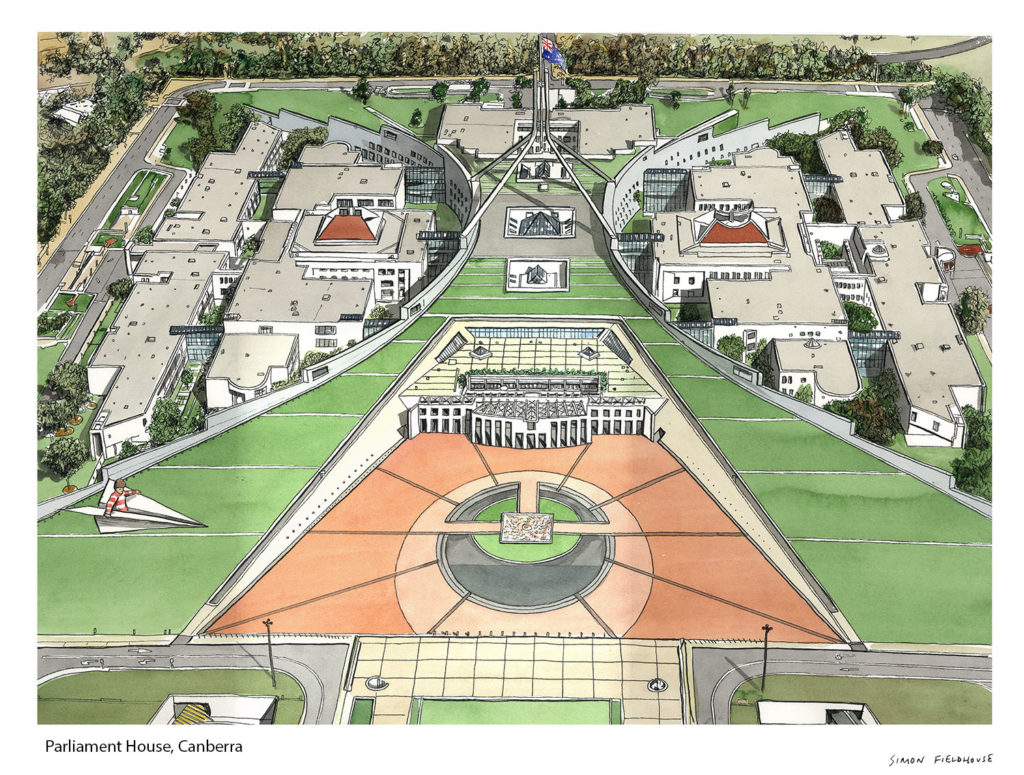
Parliament House Canberra
Parliament House, located in Canberra, the capital city of Australia, stands as an iconic symbol of the nation's democratic principles and architectural excellence. It serves as the meeting place for the country's elected representatives, housing both the Senate and the House of Representatives. The history, architecture, and cultural significance of Parliament House reflect Australia's journey towards independence, unity, and the values upon which its democracy is built.
Historical Significance:
The idea of a permanent home for Australia's federal government was first discussed in the late 19th century. However, it wasn't until 1979 that the current Parliament House, designed by renowned architect Romaldo Giurgola, was officially opened. The building's location on Capital Hill was deliberately chosen to symbolize the government's central role in Australian life. The construction of Parliament House was a momentous event in Australia's history, as it marked the nation's commitment to its democratic principles and the unification of its people.
Architectural Grandeur:
Parliament House is a masterpiece of architectural design, blending the ancient and modern, and representing Australia's unique identity. Its triangular form, partially submerged in the hill, is a homage to the ancient civilizations that have influenced the course of history. The exterior is adorned with 81,000 square meters of white granite, symbolizing purity, and a green copper roof that oxidizes over time, echoing the nation's natural landscapes. The main entrance, characterized by its towering marble columns and an 81-meter flagpole, is an awe-inspiring sight. The Great Hall, with its soaring 46-meter-high flag mast and stunning mosaic floor, further reflects the grandeur of Australian democracy.
Cultural Significance:
Parliament House serves as a beacon of democracy, welcoming visitors from all over the world. It is more than just a political institution; it is a symbol of the Australian way of life. The building's open design encourages public participation, allowing citizens to observe parliamentary sessions, engage with elected officials, and learn about the nation's political processes. This commitment to transparency and accessibility underscores Australia's deep-rooted democratic values.
The indigenous cultural significance of Parliament House is also noteworthy. The Forecourt, designed with input from Aboriginal and Torres Strait Islander communities, features an intricate mosaic depicting the creation story of the land and a ceremonial fire pit, symbolizing the enduring connection between the Australian Indigenous peoples and the land.
Conclusion:
Parliament House in Canberra is more than just a government building; it is a reflection of Australia's rich history, architectural innovation, and democratic ideals. As a testament to the nation's commitment to democracy, it stands proudly on Capital Hill, inviting citizens and visitors to participate in the democratic process and embrace the cultural richness of the land. In its history, architecture, and cultural significance, Parliament House embodies the core values of the Australian nation, and it will continue to serve as a symbol of unity and democracy for generations to come.
- Triangular Design: The most striking feature of Parliament House is its unique triangular design. This design was chosen to represent the three branches of government – the executive, the legislature, and the judiciary. The building is partially submerged into Capital Hill, creating a harmonious relationship with the surrounding landscape. This integration with the natural topography is a departure from traditional monumental architecture, reinforcing the idea that government is of the people, not above them.
- Materials: Parliament House is constructed using high-quality materials that reflect the natural beauty of Australia. The façade is clad in 81,000 square meters of white granite from Western Australia, symbolizing purity and strength. The choice of materials and the meticulous craftsmanship demonstrate a commitment to longevity and permanence.
- Green Copper Roof: One of the most distinctive features of Parliament House is its copper roof. When first constructed, the roof was a shining copper color, but it has since oxidized to a deep green. This transformation symbolizes the evolving nature of Australian democracy, with the building's appearance changing over time just as the nation itself has evolved.
- Integration with Indigenous Culture: Parliament House's design incorporates elements of indigenous culture, emphasizing the importance of acknowledging Australia's Aboriginal and Torres Strait Islander heritage. The Forecourt features a stunning mosaic in the shape of a circle, symbolizing the meeting of cultures and the center of government. The mosaic, known as the "Aboriginal Mosaic," depicts the creation story of the land and the significance of the site. It was created by Indigenous artists Michael Nelson Jagamara and Imants Tillers.
- Public Accessibility: The design of Parliament House emphasizes transparency and public engagement. Visitors can access the building's roof, which offers panoramic views of Canberra and its surroundings, and observe parliamentary sessions in the public galleries. The Great Hall, a central space within the building, serves as a hub for ceremonies, events, and exhibitions, further connecting the government with the people.
- Sustainable Design: Parliament House incorporates several sustainable design features, including natural ventilation, energy-efficient lighting, and a focus on recycling and water conservation. The building's environmental initiatives reflect Australia's commitment to preserving its natural resources and reducing its carbon footprint.
In summary, Parliament House in Canberra is a marvel of contemporary architecture that harmoniously blends modern design principles with cultural symbolism. Its triangular design, use of quality materials, integration with indigenous culture, public accessibility, and commitment to sustainability make it an enduring symbol of Australian democracy and a testament to the nation's rich architectural heritage.